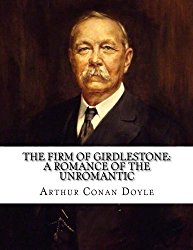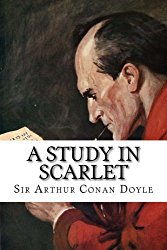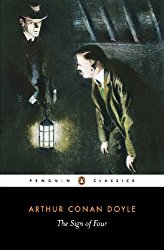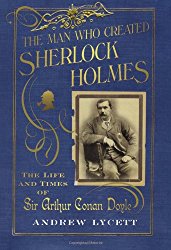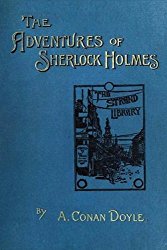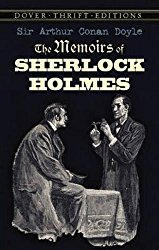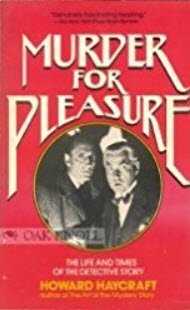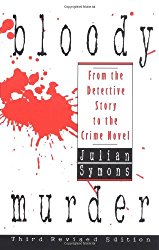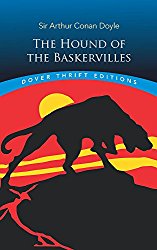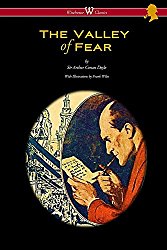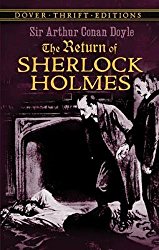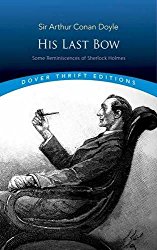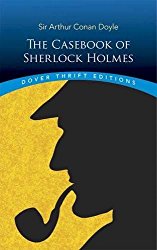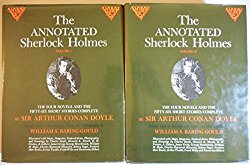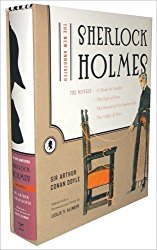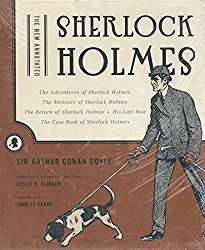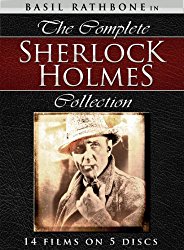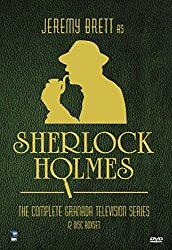Sherlock Holmes
"It is a dangerous habit to finger
loaded firearms in the pocket
of one's dressing-gown."
So said Professor Moriarty to Sherlock Holmes on the occasion of their first meeting. It was an incident that was to lead very shortly to the death of the professor of mathematics and to his criminal enterprise -- and to the death of the Great Detective Sherlock Holmes.
At first, Dr. (later Sir) Arthur Conan Doyle had been wildly excited about his creation.
When he first hung out his shingle in Southsea he had a lot of time on his hands. Few patients came calling for his services. He had always loved telling stories, and friends told him he had a knack for doing so. So he spent much of his time writing and sending out his manuscripts to be published. He was not an immediate success, although he did manage to see his name in print
Among the works he produced during this early time was an interesting piece of fiction called The Firm of Girdlestone. Although it was not to see publication for some time, it eventually did see the light of day. Sherlockians point to it as revealing the background of the woman who was to become the landlady of Sherlock Holmes -- Mrs. Martha Hudson.
|
Click Image to Click the image below to |
Mrs. Hudson was not the central character of The Firm of Girdlestone. Indeed, she only appeared near the beginning of the novel. It seems her husband, Jim, was lost at sea. Mrs. Hudson was visiting the proprietors of the Firm of Girdlestone seeking recompense, for the Firm owned the vessel upon which Jim lost his life and Martha Hudson was left a widow. But it seems the Firm was incorporated and legally owed her nothing. And that's exactly what it paid her. Her desperation from this situation may well be the motivation that drove her to acquire a house and seek tenants. |
In 1887, two of Conan Doyle's works of note were published. One was "The Mystery of Uncle Jeremy's Household," very much in the manner of what would become Doyle's style for the Sherlock Holmes stories. The narrator's name was John H. Thurston (a literary precursor to John H. Watson? Undoubtedly!).
|
The second Doyle work to see publication that year was a novel called A Study in Scarlet -- the very first Sherlock Holmes novel. It was published in the Beeton's Christmas Annual in 1887. Doyle had had a hard time getting in published. It was first rejected a number of times and, when finally accepted, Doyle accepted a pittance -- a mere twenty-five pounds, and he lost all rights to it forever. |
Click Image to Click the image below to |
Dorothy Sayers was to write that A Study in Scarlet "was flung like a bombshell on the reading public." Actually, it fizzled. Howard Haycraft's response to Sayers's statement was, "...it may have been flung like a bombshell, but it didn't explode." It came quite close to being the last the reading public would hear of the Great Detective, except for...
The Adventure of the Editor from Philadelphia
Joseph Marshall Stoddart--managing editor of Lippincott's Magazine in Philadelphia, Pennsylvania, USA--sailed across the Atlantic to encourage two authors whom he believed in. He took the authors out for dinner and urged Doyle to write another Sherlock Holmes book.
|
As Doyle turned his hand to this next project, he couldn't help reflecting on the other writer present at the dinner -- a flamboyant and eccentric hypochondriac whom Doyle parodied. This writer became the character Thaddeus Sholto in the second Holmes novel, The Sign of the Four. (See Andrew Lycett's The Man Who Created Sherlock Holmes: The Life and Times of Sir Arthur Conan Doyle, New York: Free Press, 2007, p. 229.) |
Click Image to Click the image below to |
|
Click Image to Click the image below to |
This other writer also produced a novel as an outcome from the dinner: Oscar Wilde wrote The Picture of Dorian Gray. The Sign of the Four also presented Miss Mary Morstan -- whom Holmes described as a "model client." She had some significance in the life of Dr. John H. Watson, also, for she became his wife. |
And so the two fellow lodgers -- Sherlock Holmes and Dr. John H. Watson -- were to go their separate ways. Then Doyle had an important idea... He would write a series of short stories -- all about the same character (Sherlock Holmes!). This was a new concept -- to keep the continuity by following the same protagonist through a series of short stories had never been done quite this way. To be sure, Edgar Allan Poe had written three stories about August Dupin, but these were not produced month after month in sequence.
Doyle approached The Strand magazine. His proposal was accepted, and the rest is history. The public enthusiastically embraced reading about Sherlock Holmes every month; Doyle's efforts created a whole new market for this kind of fiction and for series' characters. And the Holmes stories were collected into two volumes of short stories: The Adventures of Sherlock Holmes and The Memoirs of Sherlock Holmes.
|
Click Image to Click the image below to |
Click Image to Click the image below to |
"Sherlock Holmes -- His Limits"
When Doctor John H. Watson was first getting to know Sherlock Holmes, he wrote the following:
| I pondered
over our short conversation,
however, and endeavoured to draw my deductions from it.
He said that he would acquire no knowledge which did not bear
upon his object. Therefore all the knowledge which he
possessed was such as would be useful to him. I enumerated
in my own mind all the various points upon which he had shown
me that he was exceptionally well-informed. I even took a
pencil and jotted them down. I could not help smiling at the
document when I had completed it. It ran in this way --
|
||
| SHERLOCK
HOLMES -- his limits. |
||
| 1. Knowledge of Literature. | - | Nil. |
| 2. "
Philosophy. |
- | Nil. |
| 3. "
Astronomy. |
- | Nil. |
| 4. " Politics. | - | Feeble. |
| 5. " Botany. | - | Variable. Well up in belladonna, opium, and poisons generally. Knows nothing of practical gardening. |
| 6. " Geology. | - | Practical, but limited. Tells at a glance different soils from each other. After walks has shown me splashes upon his trousers, and told me by their colour and consistence in what part of London he had received them. |
| 7. " Chemistry. | - | Profound. |
| 8. " Anatomy. | - | Accurate, but unsystematic. |
| 9. " Sensational Literature. | - | Immense. He appears to know every detail of every horror perpetrated in the century. |
| 10. Plays the violin well. | ||
| 11. Is an expert singlestick player, boxer, and swordsman. | ||
|
12. Has a good practical knowledge of
British law.
|
||
|
When I had got so far in my list I threw
it into the fire in
despair. |
||
|
--A Study in Scarlet, Chapter 2 |
||
But, of course, Watson wrote this before he got to know Holmes better. When he did so, Holmes revealed bits of knowledge and wisdom on subjects that often surprised Watson, as in his sudden and unexpected discourse on religion.
Sherlock Holmes: "Great" and
Master Detective of "The Golden Age"
In his book Murder for Pleasure, Howard Haycraft was to call the period from 1918 to 1930 the "Golden Age" of detective fiction because of the proliferation of "Great Detectives." Julian Symons, in Bloody Murder, was to point out that there was an earlier "Golden Age" of detective fiction, that it was created by Arthur Conan Doyle and his character Sherlock Holmes, and that it came into prominence directly after Holmes was "killed" in the famous incident at the Reichenbach Falls in Meiringen, Switzerland. The death of Sherlock Holmes left a void in the marketplace. And plenty of writers were ready, willing, and able to fill it with detectives and criminals
|
Click Image to Click the image below to |
Click Image to Click the image below to |
But after two years of churning out Sherlock Holmes stories, Doyle declared that Holmes "...takes my mind from better things," alluding to his own spiritualistic activities and his desire to write historical novels, as well as other projects.
Holmes Versus Moriarty
Here is Holmes's own account of his encounter with Professor Moriarty as he told it to Dr. John H. Watson ("The Final Problem"):
| "My nerves are fairly proof, Watson, but I must confess to a start when I saw the very man who had been so much in my thoughts standing there on my threshold. His appearance was quite familiar to me. He is extremely tall and thin, his forehead domes out in a white curve, and his two eyes are deeply sunken in this head. He is clean-shaven, pale, and ascetic-looking, retaining something of the professor in his features. His shoulders are rounded from much study, and his face protrudes forward, and is forever slowly oscillating from side to side in a curiously reptilian fashion. He peered at me with great curiosity in his puckered eyes.
"'You have less frontal development than I should have expected,' said he, at last. 'It is a dangerous habit to finger loaded firearms in the pocket of one's dressing-gown.' "The fact is that upon his entrance I had instantly recognized the extreme personal danger in which I lay. The only conceivable escape for him lay in silencing my tongue. In an instant I had slipped the revolver from the drawer into my pocket, and was covering him through the cloth. At his remark I drew the weapon out and laid it cocked upon the table. He still smiled and blinked, but there was something about his eyes which made me feel very glad that I had it there. "'You evidently don't know me,' said he. "'On the contrary,' I answered, 'I think it is fairly evident that I do. Pray take a chair. I can spare you five minutes if you have anything to say.' "'All that I have to say has already crossed your mind,' said he. "'Then possibly my answer has crossed yours,' I replied. "'You stand fast?' "'Absolutely.' "He clapped his hand into his pocket, and I raised the pistol from the table. But he merely drew out a memorandum-book in which he had scribbled some dates. "'You crossed my path on the 4th of January,' said he. 'On the 23d you incommoded me; by the middle of February I was seriously inconvenienced by you; at the end of March I was absolutely hampered in my plans; and now, at the close of April, I find myself placed in such a position through your continual persecution that I am in positive danger of losing my liberty. The situation is becoming an impossible one.' "'Have you any suggestion to make?' I asked. "'You must drop it, Mr. Holmes,' said he, swaying his face about. 'You really must, you know.' "'After Monday,' said I. "'Tut, tut,' said he. 'I am quite sure that a man of your intelligence will see that there can be but one outcome to this affair. It is necessary that you should withdraw. You have worked things in such a fashion that we have only one resource left. It has been an intellectual treat to me to see the way in which you have grappled with this affair, and I say, unaffectedly, that it would be a grief to me to be forced to take any extreme measure. You smile, sir, but I assure you that it really would.' "'Danger is part of my trade,' I remarked. "'That is not danger,' said he. 'It is inevitable destruction. You stand in the way not merely of an individual, but of a mighty organization, the full extent of which you, with all your cleverness, have been unable to realize. You must stand clear, Mr. Holmes, or be trodden under foot.' "'I am afraid,' said I, rising, 'that in the pleasure of this conversation I am neglecting business of importance which awaits me elsewhere.' "He rose also and looked at me in silence, shaking his head sadly. "'Well, well,' said he, at last. 'It seems a pity, but I have done what I could. I know every move of your game. You can do nothing before Monday. It has been a duel between you and me, Mr. Holmes. You hope to place me in the dock. I tell you that I will never stand in the dock. You hope to beat me. I tell you that you will never beat me. If you are clever enough to bring destruction upon me, rest assured that I shall do as much to you.' "'You have paid me several compliments, Mr. Moriarty,' said I. 'Let me pay you one in return when I say that if I were assured of the former eventuality I would, in the interests of the public, cheerfully accept the latter.' "'I can promise you the one, but not the other,' he snarled, and so turned his rounded back upon me, and went peering and blinking out of the room. "That was my singular interview with Professor Moriarty. I confess that it left an unpleasant effect upon my mind. His soft, precise fashion of speech leaves a conviction of sincerity which a mere bully could not produce. Of course, you will say: 'Why not take police precautions against him?' the reason is that I am well convinced that it is from his agents the blow will fall. I have the best proofs that it would be so." |
"The Great Hiatus"
The period after the death of Sherlock Holmes, and before his resurrection, has come to be known among Sherlockians as "The Great Hiatus." Doyle was sick of writing about Holmes, but the public was still enthusiastic about reading him -- or seeing him in action in any form available. American actor William Gillette was called upon to write a Sherlock Holmes play, and was put in touch with Doyle.
When William Gillette was considering how to approach writing a Sherlock Holmes play, he thought it well to provide a love interest for Holmes. Audiences loved romance.
Gillette wired Doyle for his permission: "May I marry Holmes?"
Doyle responded, "You may marry, or murder, or do what you like with him."
These anecdotes demonstrate Doyle's attitude at the time toward his detective hero. But Doyle was not quite finished with Mr. Sherlock Holmes. While he was visiting a friend, he was told a local legend that he thought would make a grand mystery. Holmes, of course, was dead at this time. But Doyle realized that it would make a perfect Holmes story (after he worked through the idea of creating another detective and realizing he already had one).
|
No, he didn't resurrect Holmes -- at least not yet. He wrote the classic The Hound of the Baskervilles as a reminiscence of Dr. John H. Watson, a previously untold episode that happened to the Great Detective while he was still alive. The Hound was published in serial form in The Strand magazine and was immensely popular. Touted by many readers and reviewers as one of the best mysteries (it appeared on at least one list as one of the four best murder mystery detective stories of all time, along with The Nine Tailors by Dorothy L. Sayers, The Lodger by Mrs. Belloc-Lowndes, and Trent's Last Case by E. C. Bentley), although John Dickson Carr believes The Valley of Fear is the best Sherlock Holmes novel. |
Click Image to Click the image below to |
But there came a day when Doyle began to wish that Holmes were still alive, and he began to think of a way to revive him. During the hiatus there was still enormous interest from the reading public for more Sherlock Holmes stories. Doyle needed money, and writing more Sherlock Holmes stories was certain to bring it his way.
It was his mother who suggested the perfect solution, and Doyle wrote "The Adventure of the Empty House," explaining how it came to be that Sherlock Holmes -- long thought dead by the public, the police, and his friends -- was actually still alive.
The Resurrection of Sherlock Holmes
So Sherlock Holmes was resurrected. Doyle produced another novel about him -- The Valley of Fear -- and three more collections of short stories -- The Return of Sherlock Holmes, His Last Bow, and The Casebook of Sherlock Holmes. This final collection was published in book form in 1927, just three years before Doyle died.
|
Click Image to Click the image below to |
Click Image to Click the image below to |
Holmes was different from the myriads of detectives written about by others. We are privileged to see aspects of his life from before he met his biographer (Dr. John H. Watson) until after his retirement.
|
Click Image to Click the image below to |
Click Image to Click the image below to |
Holmes first discovered his great talent for observation and deduction while still a student. No, that's not quite accurate -- he always knew he had that talent, but he thought that everyone had it. Not so! Holmes was to discover the profound impact he was to make on others in "The Gloria Scott," an adventure he told Watson about his first realization that his unique talent was anything but commonplace.
Another early adventure Holmes related to Dr. Watson was "The Musgrave Ritual."
Years later, Holmes retired to Sussex to keep bees and study philosophy. This we know from "His Last Bow," which describes how Holmes comes out of retirement in 1914. He and Watson reunite to confound enemy agents.
These facts have provided fodder for Holmesian scholars to devote much time and energy into arranging all the stories of the Holmesian Canon into chronological sequence. In The Annotated Sherlock Holmes, William S. Baring-Gould has provided his own chronology. His annotations include a synthesis of all the major Sherlockian commentators of the day, with his own reasons for where he agrees or disagrees. (He also includes articles galore on every aspect of Holmes that could possibly be of interest to a student of Sherlock.)
Click Image to
Order from Amazon
(As an Amazon Associate
I earn from
qualifying purchases.)
Click the image below to
Read the Reviews:
Since the time of Baring-Gould's indispensable two-volume set, Sherlockian scholarship has continued. Leslie Klinger has picked up the torch and has diligently sifted through the several decades of scholarship that was nonexistent when Baring-Gould was writing. Mr. Klinger has produced an entirely new set of books with a similar title: The New Annotated Sherlock Holmes (Novels) and The New Annotated Sherlock Holmes (Stories). This is not simply an updated version of Baring-Gould's work; it is a worthy addition to the volumes of scholarship Sherlockians have produced and should find its place on the bookshelves of all serious students of Sherlockiana.
|
Click Image to Click the image below to |
Click Image to Click the image below to |
How Did Doyle Maintain Such High Standards in His Writing About Sherlock Holmes?
The Sherlock Holmes stories continue to be held in such high regard world-wide that one wonders how Doyle was able to do it. Certainly he must have re-used certain plot elements and/or devices. What did he keep in his "bag of tricks," to pull out and use as needed? And how was he able to misdirect us so we overlooked his sleight of hand tactics? "For a Moment I Thought You Had Done Something Clever" begins to explore this theme. To explore it further, see" 'The Speckled Band' and 'The Copper Beeches': A Brief Comparison." "The Adventure of the Cornish Boatman" probes the speculation by some that the later Sherlock Holmes stories were inferior to the earlier stories.
In time to come, this web page will endeavor to include more articles pertaining to more Sherlockian scholarship, the canon, the Sherlockian apocrypha, pastiches, and Holmes as portrayed in various media:
- Films (Background, Silent Film, the early "Talkies," Basil Rathbone's films, and more will be explored in this series of articles.) (Note: Sherlock Holmes -- The Complete Basil Rathbone Collection is highly recommended.)
- Television (Jeremy Brett in Sherlock Holmes: The Complete Granada Television Series (12 DVD), for example)
- Radio
|
Click Image to Click the image below to |
Click Image to Click the image below to |
And if you ever find yourself in Odessa, Ukraine, you owe it to yourself to visit the wonderful people at Cafe Sherlock.
So welcome to the web page "where it is always 1895" (apologies to Vincent Starrett!).
Click Image to
Order from Amazon
(As an Amazon Associate
I earn from
qualifying purchases.)
Amazon and the Amazon logo are trademarks of Amazon.com, Inc. or its affiliates.
(This is a link through which I make a small commission if you buy. See here for more details.)
